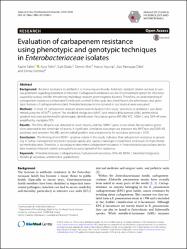Evaluation of carbapenem resistance using phenotypic and genotypic techniques in Enterobacteriaceae isolates

Göster/
Erişim
info:eu-repo/semantics/openAccessTarih
2015Yazar
Şahin, KazımTekin, Ayşe
Özdaş, Şule
Akın, Demet
Yapışlar, Hande
Dilek, Aziz Ramazan
Sönmez, Emine
Üst veri
Tüm öğe kaydını gösterKünye
Sahin, K., Tekin, A., Ozdas, S., Akin, D., Yapisler, H., Dilek, A.R., Sonmez, E., (2015). Evaluation of carbapenem resistance using phenotypic and genotypic techniques in Enterobacteriaceae isolates. Annals of Clinical Microbiology and Antimicrobials, 14. https://doi.org/10.1186/s12941-015-0105-1Özet
Background: Bacterial resistance to antibiotics is increasing worldwide. Antibiotic-resistant strains can lead to serious problems regarding treatment of infection. Carbapenem antibiotics are the final treatment option for infections caused by serious and life-threatening multidrug-resistant gram-negative bacteria. Therefore, an understanding of carbapenem resistance is important for infection control. in the study described herein, the phenotypic and genotypic features of carbapenem-resistant Enterobacteriaceae strains isolated in our hospital were evaluated. Methods: in total, 43 carbapenem-resistant strains were included in this study. Sensitivity to antibiotics was determined using the VITEK (R) 2 system. the modified Hodge test (MHT) and metallo-beta-lactamase (MBL) antimicrobial gradient test were performed for phenotypic identification. Resistance genes IMP, VIM, KPC, NDM-1, and OXA-48 were amplified by multiplex PCR. Results: the OXA-48 gene was detected in seven strains, and the NDM-1 gene in one strain. No resistance genes were detected in the remainder of strains. A significant correlation was observed between the MHT test and OXA-48 positivity, and between the MBL antimicrobial gradient test and positivity for resistance genes (p < 0.05). Conclusion: the finding of one NDM-1-positive isolate in this study indicates that carbapenem resistance is spreading in Turkey. Carbapenem resistance spreads rapidly and causes challenges in treatment, and results in high mortality/morbidity rates. Therefore, is necessary to determine carbapenem resistance in Enterobacteriaceae isolates and to take essential infection control precautions to avoid spread of this resistance.

















